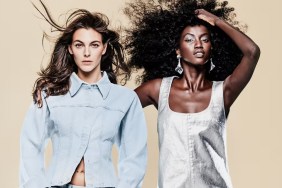
His work has influenced photographers as diverse as Nick Night, David LaChappelle, Mert Alas, and Marcus Piggot, and he continues to be widely imitated.Guy Bourdin began as an artist exhibiting drawings in the galleries of Paris. He learned photography as a cadet in the French Air Force while stationed in Senegal. He was greatly impressed by the work of surrealist artist Man Ray, who became a mentor to Bourdin early in his career. While he continued a successful career as an artist, his photographs began to catch on in the French fashion world.
From the beginning, he pushed against the accepted tenets of fashion photography. His first layout featured a model in a picture hat below a row of dead calves’ heads. More than any other photographer of his time, he borrowed from the art world, from the works of Magritte and Balthus, and infused his images of models with a surrealistic edge. He said of his work: “For me, photography was a means of expressing my wonderment at objects, or of celebrating the poetry of nature, and the melancholy of passing time.”
The late 60’s and 70’s saw a change in his work as he discovered color. He began working with shoe designer Charles Jourdan in 1967, creating ads that were nearly pornographic in their overt sexuality. His love of texture and color lifted what could have been mundane photographs of shoes to new heights. The ads tell stories – sometimes disturbing, always sexual.
Strange things happen here, like bleeding light sockets; legs fly up into the air as women go bottoms up, their shoes waving in the air; a woman lies on a bed with a towel covering her lap, but only her shoes are lit. His were unsettling ads that left we, the viewers, thinking, “what just happened here?” The shoes aren’t just the product, they are part of the plotline, leaving us greedily looking forward to seeing the rest of the story.
Bourdin used a harsh light that became synonymous with his era. A hard flash that falls off into hard shadows, like the work of newspaper photographer Weegee. It’s a light that makes you think of paparazzi. It has an urgency that drives the image forward and off the page. His masterful use of color is like that of Matisse or Rothko – large fields of bright primaries that embrace and surround the subject, lending the images emotional tone and mystery.

So impactful was this combination of lighting and color that Alas and Piggott imitated it in their ground-breaking “City Slickers” spread for W magazine in August of 2006. Their appropriation of Bourdin’s style, and his penchant for latex bondage leggings was the most exciting thing that year (and gave us the shiny legging trend, which was first seen in Bourdin’s disco era).
In Bourdin’s world, there was no room for error. He is said to have left actress Ursula Andress lying on a table while he frantically searched for roses that exactly matched the shade of her skin. He is said to have covered a baby’s skin in tiny pearls, and photographed the child until it passed out. He was dictatorial and controlling, and models said that you had to be a masochist to work with him.
He used models as a sculptor would use clay, bending and twisting them to meet the standards of his exacting vision. The hair and make-up were stylized – red lips, strong blush, and heavily shadowed eyes. Hair is most often curled and waved, cascading over shoulders, or flung about. It’s a mixture of 40’s and 50’s glamour, updated. You can see this look and his style recreated in the current Lord & Taylor ads.
Guy Bourdin, along with French Vogue peer Helmut Newton, brought sex and danger into fashion photography. Bourdin often depicts women as sexual victims, and he (along with Newton) was accused of being a misogynist. Models are splayed out on the floor naked with blood dripping from their mouths, or they squat with their legs wide open, feet planted on the ground. It’s a crude sexuality that can only lead to disaster. There is often a feeling of unease – something bad is about to happen, or just did happen and we are seeing the effect of the act but never the act itself. He brought a tension to fashion that was very different from the studied elegance in the work of Avedon or Penn, his American counterparts. His work was not safe or familiar, and that’s what made it uniquely Bourdin.
Although he wanted all of his work destroyed after death, enough remained to be collected in a book, Exhibit A, which was published in 2001, 10 years after his death.
You can learn more about Guy Bourdin at GuyBourdin.net. For a collection of his films, check out Showstudio.








